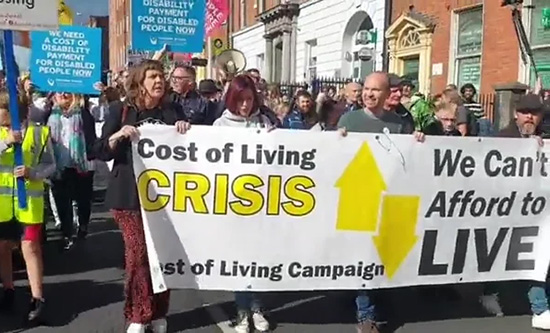
The 26 Counties in the south of Ireland has the second highest GDP per capita in Europe. In 2022 the Republic of Ireland reported a 12% expansion in GDP, helping the entire eurozone dodge stagnation (Financial Times, 2 June). It is so wealthy it is considering opening a sovereign wealth fund to store its money. This wealth is completely unstable, dependent on having one of the lowest corporation tax rates in Europe and reliant on a handful of US corporations using the 26 Counties as their European base. It all comes at the expense of working class people in Ireland as the cost of living soars, the housing crisis deepens and social welfare is cut.
US multinational dominance
The 26 Counties has grown rich by establishing itself as an entry point for US companies into Europe. It has the second lowest corporation tax rate in the eurozone. The Irish state infamously rejected a €13bn backdated tax payment from Apple in 2016, following years of paying as little as 0.005% in taxes using the now-closed controversial ‘double Irish’ tax loophole. This loophole was the state effectively subsidising multinational corporations. It is currently resisting pressure from the EU to raise its corporation rate from 12.5% to 15% for companies earning in excess of €750m. Even if it did rise to 15% it would still be the third lowest rate in the eurozone and significantly lower than Italy’s 24%, Britain’s, Spain’s and France’s 25% and Germany’s 30%.
US big tech and pharmaceutical companies dominate the Irish economy. Of the top ten performing companies per revenue in 2022, just two were Irish. Eight were either US companies, subsidiaries of US companies or US-Irish mergers. US tech giants Apple, Microsoft, Google and Meta took the top four spots. Apple recorded revenue of €222.8bn in the year to September 2022 with profits of €69.5bn. Other billion-euro earners included US pharmaceutical company Regeneron and Alexion (a US subsidiary of the British-Swedish AstraZeneca).
The profits of the foreign multinationals inflate Irish GDP per capita and obscure the GDP growth rate. When looking at Gross National Income (GNI), which does not include the profits of multinationals in its metrics, in 2019 Ireland’s GNI was around 40% below the level of GDP, whereas GDP and GNI are about equal in most countries (Central Bank of Ireland, 2021). Moreover, over a quarter of all tax revenue in Ireland in 2022 was from corporation tax. Payments by foreign-owned multinationals constituted 86% of total corporation tax receipts (Irish Fiscal Advisory Council, June 2023). This shows the fragility of the Irish economy, highly dependent on the tax revenue of a few US multinationals and subject to the volatility of US tech and pharmaceutical markets.
For now, the Irish state is using US imperialism as a springboard to advance its own capitalist interests. The Irish government has forecast a €10bn budget surplus this year, compared to €8bn in 2022, and is expecting €16.2bn in 2024. It is moving towards creating a sovereign wealth fund (a state-owned investment fund) to store this windfall wealth. Norway’s was established for the long-term management and investment of the revenue from its oil and gas reserves. Its fund is now the largest single owner in the world’s stock markets, holding shares, bonds and real estate across the world. There is no indication that a sovereign wealth fund from Ireland would do anything different and is an attempt by the Irish ruling class to escape its dependency.
Working class pays
The 26 Counties is a vastly unequal state in which wealth is being increasingly concentrated in fewer hands: the richest 10% of people own 64% of wealth and the poorest 50% of people just 1%. Around 220,000 households, one in eight, are millionaires, compared to 87,000 in 2013. At the same time, more than 671,000 people are living in poverty and 133,565 of them are in employment. Wage distribution in Ireland is the most unequal in any high-income EU country, while the Irish state is the most expensive place to live in the EU.
According to the European Commission, in 2022 Switzerland and Iceland were the only countries in Europe with higher consumer prices than Ireland. The 26 Counties had among the highest costs for basic grocery items, alcohol, tobacco, energy, public transport and activities such as eating out at restaurants. Household expenditure on goods and services last year was 46% above the EU average.
Housing costs soared by 68% between 2010 and 2021, disproportionately affecting those in the private rental sector who are predominantly younger people and people in receipt of welfare who should be in social housing. One third of all people in private rented accommodation are those receiving housing benefit, as the state effectively subsidises private landlords an estimated €1bn a year (Rory Hearne, Gaffs, 2022) while building little to no social housing. Rising rents, alongside depleting housing stock, are making it increasingly impossible for younger people to move out of their parents’ homes. As many as 75% of people aged 20-29 are living with their parents.
Rather than alleviate some of this pressure with its riches, the Irish state has cut social welfare rates in real terms and has refused to commit to benchmarking core social welfare rates to 27.5% of average earnings over two years. The government is dragging its feet over implementing a limited system of refundable income tax credits to support low-paid workers that would cost €1bn – the level at which it subsidises private landlords each year, or less than one tenth of what it expects to take in budget surplus this year.
At every turn, it is working class people who are forced to shoulder the burden.
Ria Aibhilin
FIGHT RACISM! FIGHT IMPERIALISM! 295 August/September 2023




